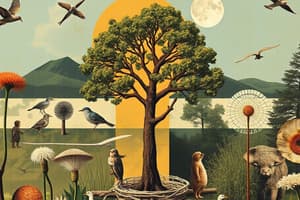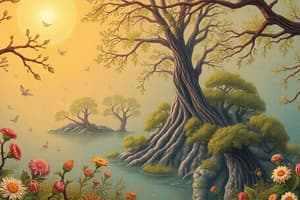Podcast
Questions and Answers
What does the biosphere consist of?
What does the biosphere consist of?
- Only the atmosphere
- All life on Earth (correct)
- Only land
- Only water
What is ecology?
What is ecology?
The scientific study of interactions among organisms and between organisms and their physical environment.
What is a species?
What is a species?
A group of similar organisms that can breed and produce fertile offspring.
What is a population?
What is a population?
What is a community?
What is a community?
What is an ecosystem?
What is an ecosystem?
What is a biome?
What is a biome?
What are biotic factors?
What are biotic factors?
What are abiotic factors?
What are abiotic factors?
What methods are used in ecological studies?
What methods are used in ecological studies?
What are primary producers?
What are primary producers?
What are autotrophs?
What are autotrophs?
How do consumers obtain energy and nutrients?
How do consumers obtain energy and nutrients?
What are heterotrophs?
What are heterotrophs?
What are carnivores?
What are carnivores?
What are herbivores?
What are herbivores?
What are omnivores?
What are omnivores?
What are scavengers?
What are scavengers?
What are decomposers?
What are decomposers?
How does energy flow through ecosystems?
How does energy flow through ecosystems?
What is a food chain?
What is a food chain?
What is a food web?
What is a food web?
What do ecological pyramids illustrate?
What do ecological pyramids illustrate?
How does matter move through the biosphere?
How does matter move through the biosphere?
What is nitrogen fixation?
What is nitrogen fixation?
What is denitrification?
What is denitrification?
What is limiting nutrient?
What is limiting nutrient?
Flashcards are hidden until you start studying
Study Notes
Biosphere and Ecology
- The biosphere includes all life on Earth and the environments where life exists (land, water, atmosphere).
- Ecology is the scientific study of interactions among organisms and between organisms and their physical environment.
Biological Groups
- A species is defined as a group of similar organisms that can interbreed and produce fertile offspring.
- A population consists of individuals of the same species living in a specific area.
- A community is an assembly of different populations living together in a defined area.
- An ecosystem encompasses the organisms in a particular area along with their physical environment.
- A biome is a collection of ecosystems that share similar climates and characteristic organisms.
Biotic and Abiotic Factors
- Biotic factors refer to living components in an environment, such as animals, plants, and microorganisms.
- Abiotic factors include nonliving elements like sunlight, temperature, water, and soil types.
Ecological Methods
- Modern ecological studies utilize three methodologies: observation, experimentation, and modeling, guided by the scientific method.
Producers and Energy Acquisition
- Primary producers generate energy-rich compounds for use by other organisms and are mainly autotrophs.
- Autotrophs capture energy from sunlight or chemicals, transforming it into usable forms.
- Photosynthesis is the process of converting sunlight into energy-rich carbohydrates, while chemosynthesis uses chemical energy to create carbohydrates.
Consumers and Their Types
- Consumers, or heterotrophs, obtain energy by consuming other organisms.
- Different types of consumers include:
- Carnivores: Animals that eat other animals (e.g., snakes, dogs).
- Herbivores: Animals that consume plant material (e.g., cows, deer).
- Omnivores: Organisms that eat both plants and animals (e.g., humans, bears).
- Scavengers: Animals that feed on dead organisms (e.g., vultures).
- Decomposers: Organisms that break down organic material (e.g., bacteria, fungi).
- Detritivores: Feed on detritus particles, assisting in decomposition (e.g., earthworms, snails).
Energy Flow in Ecosystems
- Energy flows through ecosystems in a unidirectional manner, passing from primary producers to various consumers.
- Food chains illustrate energy transfer through a sequence of feeding relationships.
- Food webs represent complex networks of feeding interactions across multiple organisms.
Ecological Pyramids
- Ecological pyramids display the distribution of energy, biomass, and the number of organisms at each trophic level.
- A pyramid of energy indicates energy availability, a biomass pyramid shows the living organic matter, and a pyramid of numbers reflects individual organism counts.
Matter Cycles in the Biosphere
- Unlike energy, matter within ecosystems is recycled.
- Biogeochemical cycles depict movements of essential elements among organisms and the environment.
Nutrient Cycling
- Water continuously cycles between oceans, the atmosphere, and land, infiltrating living organisms and nonliving environments.
- Nutrients are vital chemical substances that organisms require for life processes.
- Essential nutrient cycles involve carbon, nitrogen, and phosphorus, which are crucial for sustaining life.
Nutrient Fixation Processes
- Nitrogen fixation involves bacteria converting nitrogen gas from the atmosphere into ammonia for use by living organisms.
- Denitrification is the process where soil bacteria convert nitrates back into nitrogen gas, releasing it into the atmosphere.
Primary Productivity and Nutrient Limitation
- An ecosystem's primary productivity may be constrained by nutrient availability, even when sunlight and water are abundant.
- Limiting nutrients are the specific nutrients whose presence restricts productivity in ecosystems.
Studying That Suits You
Use AI to generate personalized quizzes and flashcards to suit your learning preferences.




